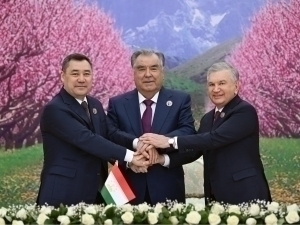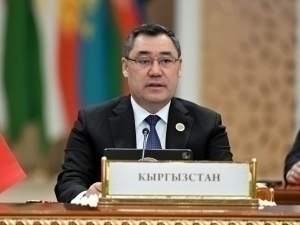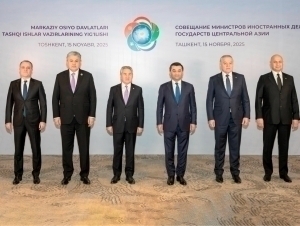Bridging borders: The role of Uzbekistan in Central Asia’s peace process
Review
−
14 March 18223 7 minutes
"Neighborly peace is personal peace." (Qo‘shning tinch – sen tinch) This is not just a wise saying passed down by elders—it has, in many ways, become Uzbekistan’s guiding principle. However, due to the intricate and problematic borders drawn during the Soviet era, neither Uzbekistan nor its neighboring fraternal nations could fully embrace this motto for decades.
For years, blood ties were overshadowed by territorial disputes, turning once-brotherly nations into adversaries. Borders were closed, and in some areas, even mined. Yet, the winds of change began to blow when Uzbekistan took the first step in opening its long-shut gates, encouraging others to follow suit. Today, that spirit of reconciliation continues with Tajikistan and Kyrgyzstan.
The latest development—a historic agreement between the two nations—marks a turning point in regional stability. On March 13, 2025, Tajikistan’s President Emomali Rahmon and Kyrgyzstan’s President Sadir Japarov signed an agreement on the delimitation and demarcation of their shared border. This landmark event, held in Bishkek during Rahmon’s state visit, has officially reopened a border that had remained closed since 2021.
"Today, we are making a historic decision regarding our border issues. The package of agreements signed today will open a new chapter in Tajik-Kyrgyz relations," Rahmon stated at the meeting.
Japarov, in turn, praised the efforts of both governments’ commissions in finalizing the border agreement. The two leaders also jointly reopened the “Kyzyl-Bel – highway” and “Kayragoch – highway” checkpoints via an online ceremony.
Why Was This Border Closed?
The Tajik-Kyrgyz border stretches 1,006.84 kilometers, of which 308 kilometers had remained unmarked for years. The Soviet-era cartographers had deliberately left these areas ambiguous, a tactic designed to ensure continued Russian influence over the region.
Following the USSR’s collapse, these unresolved borderlines became flashpoints for local disputes, often escalating into armed confrontations. As tensions flared between civilians, border troops inevitably became involved.
The official delimitation process began in 2002, but it was fraught with challenges. Tajikistan based its territorial claims on maps from 1924-1939, while Kyrgyzstan relied on documents from 1958-1959 and 1989. This discrepancy made negotiations particularly complex.
Over the past two decades, nearly 100 clashes have erupted along the border, resulting in numerous casualties on both sides.
The most significant conflict occurred in April 2021, when a routine dispute between residents in the village of Koktash spiraled into a full-scale military confrontation.
The immediate trigger? A surveillance camera.
Tajik authorities had installed a camera on a water distribution facility to monitor access, sparking outrage among Kyrgyz villagers. What started as a local argument quickly escalated, drawing in military forces. By the time the dust settled, 55 people were dead, and 205 were wounded.
A state of emergency was declared in several Kyrgyz villages. Both sides accused each other of instigating the violence, while border guards exchanged fire.
Amidst the chaos, Uzbekistan stepped in as a mediator.
Tashkent issued an official statement urging both sides to exercise restraint and resolve the crisis through dialogue, emphasizing the shared history and cultural ties that bind the people of Central Asia. Uzbek President Shavkat Mirziyoyev personally called Rahmon and Japarov, urging them to de-escalate the situation.
Though the fighting eventually subsided, new clashes erupted in March and September 2022—with even deadlier consequences.
The 2022 conflict resulted in 94 fatalities, marking it as the bloodiest episode in Kyrgyz-Tajik border history.
- Kyrgyzstan reported 59 deaths and 144 injuries.
- Tajikistan confirmed 35 civilian casualties and 25 wounded, including women and children.
Both sides deployed tanks, mortars, rocket artillery, and drones, turning the conflict into a full-scale battle. Entire villages were burned down, and more than 500 homes and buildings were reduced to rubble.
In response, September 19 was declared a national day of mourning in Kyrgyzstan.
As the world watched, major powers like Russia and the United States voiced concern over the escalating violence. Yet, once again, it was Uzbekistan that played the key role in defusing tensions.
Tashkent maintained constant diplomatic pressure, facilitating negotiations and direct talks between Dushanbe and Bishkek.
In the last decade, more than ten major conflicts have erupted along the Kyrgyz-Tajik border. Kyrgyzstan has successfully settled its border disputes with China, Kazakhstan, and Uzbekistan, leaving Tajikistan as the final unresolved neighbor—until now.
Uzbekistan has not been immune to border conflicts with its neighbors. In 1999-2000, citing the threat of cross-border terrorism, the country unilaterally began demarcating and mining sections of its borders. By 2001, Uzbekistan sought to formalize an agreement on border delimitation and proposed replacing roads connecting enclaves with the mainland. However, Kyrgyzstan rejected the proposal, prolonging tensions along their shared border.
One of the most tragic episodes in Central Asia’s modern history unfolded in June 2010, when an ethnic conflict erupted in southern Kyrgyzstan between local Kyrgyz and Uzbek communities. Known as the “Osh events,” the violence resulted in approximately 500 deaths and over 1,000 injuries, while more than 100,000 Uzbeks fled to neighboring Uzbekistan.
In addition to the human toll, the destruction was immense. More than 3,500 properties were burned to the ground—only 275 of which were state-owned. The overwhelming majority were homes, leaving thousands displaced. The devastation underscored an urgent need to prevent such tragedies from recurring, pushing Uzbekistan to actively work on border resolutions with its neighbors.
One of the main obstacles to border delimitation in Central Asia has been the lack of a universally accepted legal framework. Without a standardized agreement, border disputes frequently turned into diplomatic standoffs—or worse, violent clashes. This vacuum allowed external powers, such as Russia, to step in as arbitrators whenever disputes arose. However, recognizing the need for regional self-sufficiency, Uzbekistan prioritized resolving border issues directly with its neighbors.
In 2022, Uzbekistan and Kyrgyzstan initiated negotiations to settle their outstanding border disputes. This effort concluded successfully in November 2023, marking a milestone in bilateral relations. The demarcation process with Kazakhstan began in spring 2004 and was officially completed in 2015. In November 2022, Kazakhstan ratified an agreement with Turkmenistan, finalizing their shared border.
On May 30-31, 2017, Uzbek and Tajik officials met in Dushanbe to discuss territorial and border issues. One of the most significant outcomes was the removal of landmines along their shared border, signaling a move toward trust and cooperation. That same year, the Uzbek-Turkmen border was also reopened. While Uzbekistan and Tajikistan have made significant progress, a 60-kilometer section of their 1,332.9-kilometer border remains unresolved. Talks are ongoing, and both sides have expressed a commitment to eliminating these last remaining disputes.
A major development was announced on March 13, 2025, when Tajik President Emomali Rahmon revealed plans for a three-nation border agreement between Uzbekistan, Kyrgyzstan, and Tajikistan.
"Together with today's agreement on the Tajik-Kyrgyz border, we have also reached an understanding with esteemed Sadir Nurgudzhoevich [Japarov] to finalize the point of intersection of our three nations' borders," Rahmon stated after meeting Kyrgyz President Sadir Japarov in Bishkek.
The agreement is set to be officially signed on March 31 in Khujand, coinciding with the Navruz celebrations. On that day, the three Central Asian leaders will not only finalize border discussions but also explore a historic regional integration initiative. Kyrgyz President Sadir Japarov has proposed the introduction of a single visa system for Central Asia, akin to the Schengen visa in Europe.
"Now that all border issues have been resolved, the region should take the next step: creating a unified visa system. This would allow travelers to move freely across all Central Asian countries, boosting tourism and economic ties," Japarov suggested.
As Central Asian nations resolve their long-standing disputes, Uzbekistan has played a leading role in fostering diplomacy and stability. By prioritizing dialogue over conflict, the region is moving toward a future where borders are no longer barriers but bridges for cooperation. The commitment to mutual respect and understanding is not just about political agreements—it is about securing a lasting peace for generations to come.




